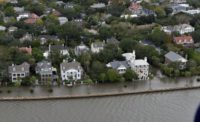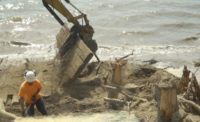Pine Knoll Shores, a small barrier island town on North Carolina’s Crystal Coast, is known for its sandy beaches, a popular aquarium—and for flooding when major storms blow in along the coast.
“People here are used to being in the path of hurricanes, tropical storms, major rain events, floods and everything else,” says Mayor John Brodman. “We try and plan to deal with severe weather events as best as we can over time. Money and everything else is always in short supply.”
The town has taken a multi-pronged approach to protecting itself. Officials have passed ordinances to limit impervious coverage. Its long-running beach maintenance program has provided a model for other seaside communities. Despite the frequent flooding—which often leaves much of the town underwater—the town's population has continued to grow, requiring more infrastructure and leaving more people and property at risk.
Now, Pine Knoll Shores is one of 25 communities getting help dealing with future floods thanks to a North Carolina Division of Coastal Management (DCM) program that is funding the planning and building of projects to protect local infrastructure. The North Carolina Resilient Coastal Communities Program (RCCP) has already awarded $675,000 in grants to those communities for the first two phases of the program, and Phases 3 and 4 may see those communities seeking engineering firms and contractors for dozens of flood mitigation projects.
Phase 3 will include the design and engineering of specific projects, and Phase 4 will be building or implementing those projects. The DCM anticipates opening Phase 3 applications as soon as December 2021.
Hurricanes and other severe weather in these communities can cause storm surge and flooding from heavy rain. State climate reports have projected those problems will only worsen. Two of North Carolina’s deadliest and most-damaging hurricanes, Matthew and Florence, have occurred in the last five years. Flooding from Hurricane Matthew caused $1.5 billion in damage in North Carolina, according to the Federal Emergency Management Agency. And more than $2 billion in federal and state assistance went to North Carolina following Hurricane Florence.
The DCM recently selected 10 firms to work with different towns and counties along the coast for the first two phases of its RCCP. Work began in August. The goal is to have those communities, with some outside help, protect themselves against loss of life and economic impact from future flooding.
Pine Knoll Shores was also one of five communities that participated in a pilot program with the DCM from 2016 to 2018 that served as the basis for the RCCP. The pilot helped the town map out its critical infrastructure and identify pieces vulnerable to flooding.
“We’ve been using that, whenever we have the money, to harden our infrastructure,” Brodman said.
The town's projects since the pilot program have included stormwater systems to collect rain in catch basins and filter it through wetlands before it flows into the sound, which Brodman says helps protect local water quality. The town also worked with the Crystal Coast Country Club to build a gravity flow series of collection lines leading into ponds on the club’s golf course. The ponds flow into one pond at the east end of town where a pump allows officials to move water into a catch basin and filter it out into the sound. They can use the pump to lower the water level in ponds ahead of large storms, and Brodman said it’s been a big help, at least for that portion of town.
Even with those efforts, Pine Knoll Shores still needs more help The barrier island where the town sits is roughly bowl-shaped, lower in the center and higher on the sides near the beach and the sound. So when there’s a lot of rain, water collects in the center of the island and the water table rises. And as the town continues to grow, it faces new vulnerabilities. Participating in the RCCP helps locals see how other communities and professionals deal with similar problems, which also helps, says Brodman.
“It’s going to help a small town like Pine Knoll Shores by providing us with information on how other people prioritize expenditures of money to make them more resilient,” he said. “It’s going to be a really good information program for us. So we’re really interested in participating and trying to stay ahead of the curve.”
Pine Knoll Shores is going to be working with professional services firm Dewberry on the first two phases of the RCCP. Dewberry was awarded a $90,000 contract to work with the town, in addition to Cape Carteret, Swansboro and Craven counties, to engage community members, assess vulnerabilities and plan projects.
Beth Smyre, a project manager at Dewberry, said in a statement the goal is to find ways to benefit the communities for years to come.
“Resilience planning is critical to a community’s ability to respond and recover from climate-generated events,” Smyre said.
The other Phase 1 and 2 contracts include:
- $90,000 with Kimley-Horn for the communities of Vandemere, Pamlico County and Hyde County;
- $75,000 with Kleinfelder for Surf City, Topsail Beach and North Topsail Beach;
- $90,000 for Moffatt & Nichol for Leland, Navassa and Sunset Beach;
- $60,000 for RK&K Civil Engineering for Beaufort County, Belhaven, Aurora and Washington;
- $60,000 for Mid-East Commission, also for Beaufort County, Belhaven, Aurora and Washington;
- $30,000 for Stewart-CPE for the Town of Beaufort;
- $120,000 for SWCA Environmental Consultants for Windsor, Hertford County, Hertford and Bertie County;
- $30,000 for Vanasse Hange Brustlin, Inc. for Duck and Nags Head; and,
- $60,000 for WithersRavenel for Currituck County and Dare County.
So far, the coronavirus pandemic has proven to be the biggest challenge because it’s harder to gather feedback from residents when officials can’t hold large townhall-style meetings, says Brodman.
As the program moves forward, local leaders are worried support from state officials could wane if the price of the proposed projects is too high. Funding for the RCCP has come from both the North Carolina state legislature and the National Fish and Wildlife Foundation.
“That’s an ambitious, long-term program right there,” he said. “I think the big risk here is, will politics support completion of the program? Because funding may change over the years, or priorities may change before we ever get to Phase 4 implementation.”






Post a comment to this article
Report Abusive Comment